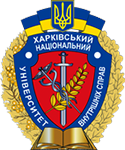Кримінально-правова характеристика зброї масового знищення як конструктивної об’єктивної ознаки складу кримінального правопорушення (статті 439, 440 КК України)
Анотація
Досліджено норми міжнародного та національного законодавства, які визначають поняття зброї масового знищення, зокрема хімічної, біологічної (зокрема, токсинної) та ядерної зброї. Розглянуто доктринальні підходи до розмежування предмета, засобу та знаряддя вчинення кримінального правопорушення, на підставі чого зроблено висновок, що зброя масового знищення у складі злочину, передбаченого ст. 440 КК України, є предметом, а у складі злочину, передбаченого ст. 439 КК України, – знаряддям учинення кримінального правопорушення. Підтримано позицію науковців, які вважають, що у складі злочину «застосування зброї масового знищення» (ст. 439 КК України) ядерна зброя не входить до змісту поняття «зброя масового знищення».
Завантаження
Посилання
Adamovych, S. V., Hrytsan, O. A., Zahurskyi, O. B. et al. (2017). Nuclear safety: international and national dimension (V. I. Rozvadovskyi, Ed.). Editorial Office of the magazine “Labor Protection”.
Aliieva, A. V. (2021). The subject of a criminal offense: concepts, types and meanings [Candidate thesis, Yaroslav Mudryi National Law University].
Aliieva, O. M., Bilash, O. V., Babii, A. P. et al. (2012). Criminal Code of Ukraine (Ye. L. Steltsov, Ed.). Odysseus.
Andreichyn, M. A., & Kopcha, V. S. (2005). Bioterrorism. Medical resistance. Ukrmedknyha.
Baulin, Yu. V., Borysov, V. I., Kyrychko, V. M. et al. (2015). Criminal law of Ukraine. Special part (V. Ya. Tatsii, V. I. Borysov, V. I. Tiutiuhin, Eds.). Rights.
Bondarenko, O. S. (2016). The subject of crimes in the field of official activity and professional activity related to the provision of public services [Candidate dissertation, National Academy of Internal Affairs].
Bronevytska, O. M. (2011). Correspondence of the criminal legislation of Ukraine with current international treaties [Candidate thesis, Lviv State University of Internal Affairs].
Haltsova, V. V. (2019). Crimes against peace and international legal order (M. I. Panov, Ed.). Yurait.
Kuchevska, S. P. (2009). Problems of harmonization of the legislation of Ukraine on criminal liability and the Statute of the International Criminal Court [Candidate dissertation, Lviv State University of Internal Affairs].
Melnyk, M. I., & Khavroniuk, M. I. (Eds.). (2018). Scientific and practical commentary on the Criminal Code of Ukraine. Dakor.
Mierzejewski, J., & Goldblat, J. (1992). Protokol Genewski. Wojskowy Przeglajd-Historyczny, 38(4), 269-278.
Mokhonchuk, S. M. (2006). Weapons of mass destruction as an object of the crime provided for in Article 439, 440 of the Criminal Code of Ukraine. Ukrainian Scientific Notes, 2(18), 218-223.
Mokhonchuk, S. M. (2014). Criminal and legal protection of peace and security of mankind [Doctoral thesis, Yaroslav Mudryi National Law University].
Muzyka, A. A., & Lashchuk, Ye. V. (2011). The subject of crime: theoretical foundations of knowledge. PALYVODA A. V.
Panov, M. I., Baulin, Yu. V., Borysov, V. I. et al. (2010). Criminal law of Ukraine. Common part (V. V. Stashys, V. Ya. Tatsii, Eds.). Right.
Petro, J. B., Plasse, T. R., & McNulty, J. A. (2003). Biotechnology: Impact on biological warfare and biodefense. Biosecurity and Bioterrorism, 1, 161-168.
Piddubna, M. V. (2020). Implementation of the norms of international criminal law on war crimes in the Criminal Code of Ukraine [Candidate thesis, Koretsky Institute of State and Law of National Academy of Science of Ukraine].
Pluzhnik, O. I. (2013). Criminal law of Ukraine. Special part. Odesa State University of Internal Affairs.
Popovych, V. P. (2010). Implementation of norms of international humanitarian law in the criminal legislation of Ukraine [Candidate thesis, Lviv State University of Internal Affairs].
Romaniuk, B. V., & Bantyshev, O. F. (2018). Crimes against peace, security of humanity and international legal order. Krok.
Romanivka, Z. Ye. (2019). The instruments and means of the crime as a sign of the objective side of its corpus delicti. Comparative and Analytical Law, 6, 414-416. http://pap-journal.in.ua/wp-content/uploads/2020/08/PAP_6_2019.pdf.
Romanivka, Z. Ye. (2020). Tools and means of committing a crime under the criminal law of Ukraine [Candidate thesis, Koretsky Institute of State and Law of National Academy of Science of Ukraine].
Shkatula, Yu. V., & Mishchenko, Yu. O. (managers). (2016). General characteristics of chemical weapons: methodological instructions for a practical lesson in the discipline “Military toxicology and radiology”. Sumy State University.
Smolianiuk, V. F. (1999). Weapons of mass destruction. In Yu. S. Shemshuchenko, F. H. Burchak, M. P. Ziabliuk et al. (Eds), Legal Encyclopedia (Vol. 2) (561-563). Ukrainian Encyclopedia.
Telpis, M. V. (2018). Instruments and facilities of committing a crime as a obligatory sign of the objective side of corpus delict. Uzhhorod National University Herald. Series: Law, 53(2), 82-87.
Telpis, M. V. (2019). Criminal law characteristics of tools and means of committing a crime [Candidate thesis, Yaroslav Mudryi National Law University].
Telpis, M. V. (2019). Distinguishing the tools and means of committing a crime from the object of the crime. Law and Society, 3(2), 194-200. https://doi.org/10.32842/2078-3736-2019-3-2-33.
Yatsenko, S. S. (Ed.). (2006). Scientific and practical commentary to the Criminal Code of Ukraine. A.S.K.
Авторське право (c) 2022 О. В. Шамсутдінов

Ця робота ліцензується відповідно до Creative Commons Attribution 4.0 International License.



